🤓 The 2026 Local Search Ranking Factors are here!! Check out the report!
🤓 The 2026 Local Search Ranking Factors are here!! Check out the report!

In local SEO, title tags are one of the most critical on-page rankings signals. But many local businesses are missing out when it comes to adding title tags, let alone optimizing them. In today’s Whitespark Weekly episode, Darren discusses the critical elements you need to include in your title tags to help increase your local traffic and click-through rate.
Hey there, Darren here with another Whitespark Weekly video. Today I want to talk to you about the importance of the title tag and show you how to write an ideal title tag for local SEO that’ll both improve your rankings and help you drive more clicks from the search results.
First off, what is the title tag? First thing to think about is that the title tag actually doesn’t appear on a web page. It’s not a heading. It’s defined in your HTML source code. If you look in the source code, you’ll see <title> and then </title> to close it. It’s an important tag in the HTML source code.  Most website editors provide some kind of way to edit the title tag, except (inexplicably) WordPress. I don’t understand why WordPress doesn’t have the ability to edit title tags on a page by page basis. In order to do this on WordPress, you need to install a plugin like Yoast or any of the SEO plugins that allow you to edit the title tag on each individual page. The titles are really important because Google uses them to display your snippet in the search results. So whatever page is ranking, Google pulls that title and displays that in the blue text in the search results. These blue headings are the title tags, it’s one of the most important elements you can optimize to improve your rankings.
Most website editors provide some kind of way to edit the title tag, except (inexplicably) WordPress. I don’t understand why WordPress doesn’t have the ability to edit title tags on a page by page basis. In order to do this on WordPress, you need to install a plugin like Yoast or any of the SEO plugins that allow you to edit the title tag on each individual page. The titles are really important because Google uses them to display your snippet in the search results. So whatever page is ranking, Google pulls that title and displays that in the blue text in the search results. These blue headings are the title tags, it’s one of the most important elements you can optimize to improve your rankings.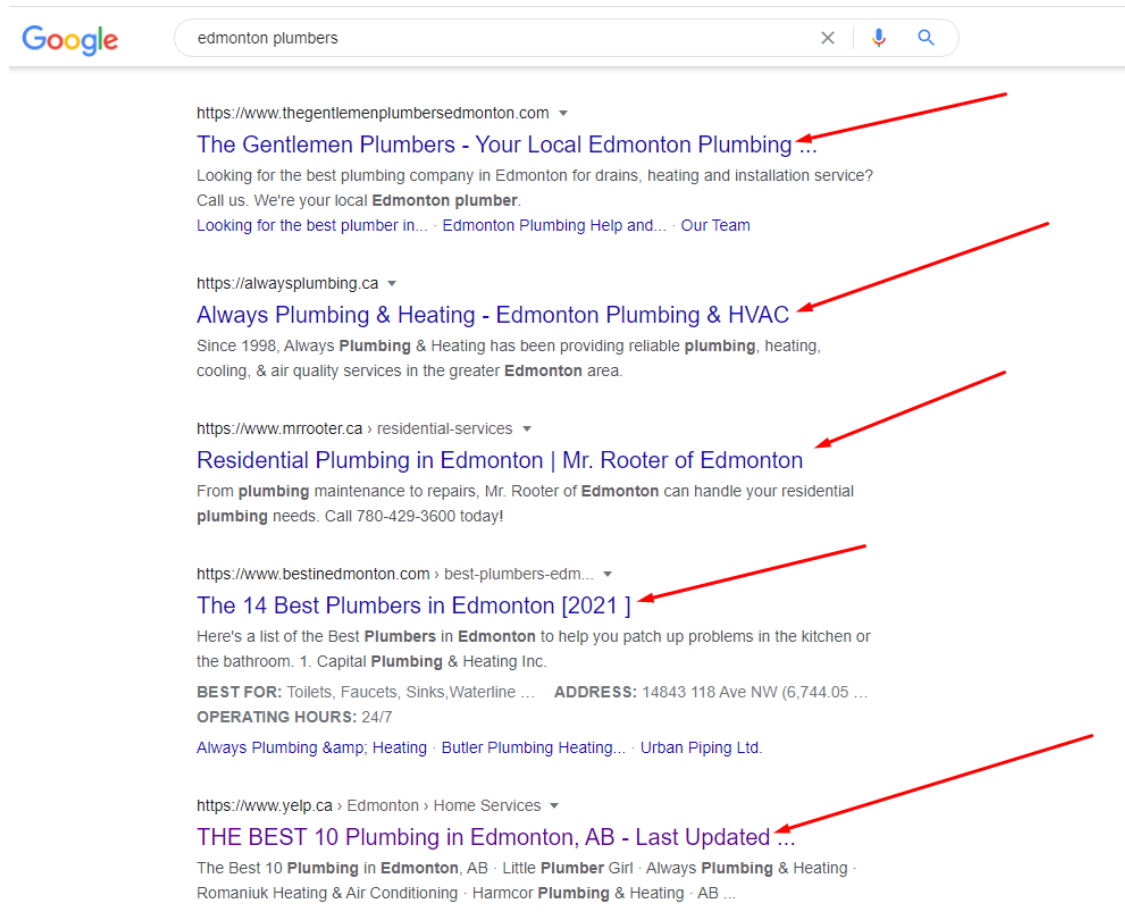 If you look at any SEO guide, there’s not a single one written that doesn’t talk about the importance of the title tag and how it is used to rank web pages. If you do a search for SEO title tags, you will see 12.4 million articles talking about title tags. It’s a huge topic and an important thing to optimize.
If you look at any SEO guide, there’s not a single one written that doesn’t talk about the importance of the title tag and how it is used to rank web pages. If you do a search for SEO title tags, you will see 12.4 million articles talking about title tags. It’s a huge topic and an important thing to optimize.
It’s also a really important ranking signal in the local search results. In the 2020 Local Search Ranking Factors survey, it came in at number 13 as the most important ranking factor. And 13 might seem like it’s kind of low on the list, but not when you consider there’s 122 factors that the survey participants had to sort. It came in even higher as a local organic ranking signal, at number 8. 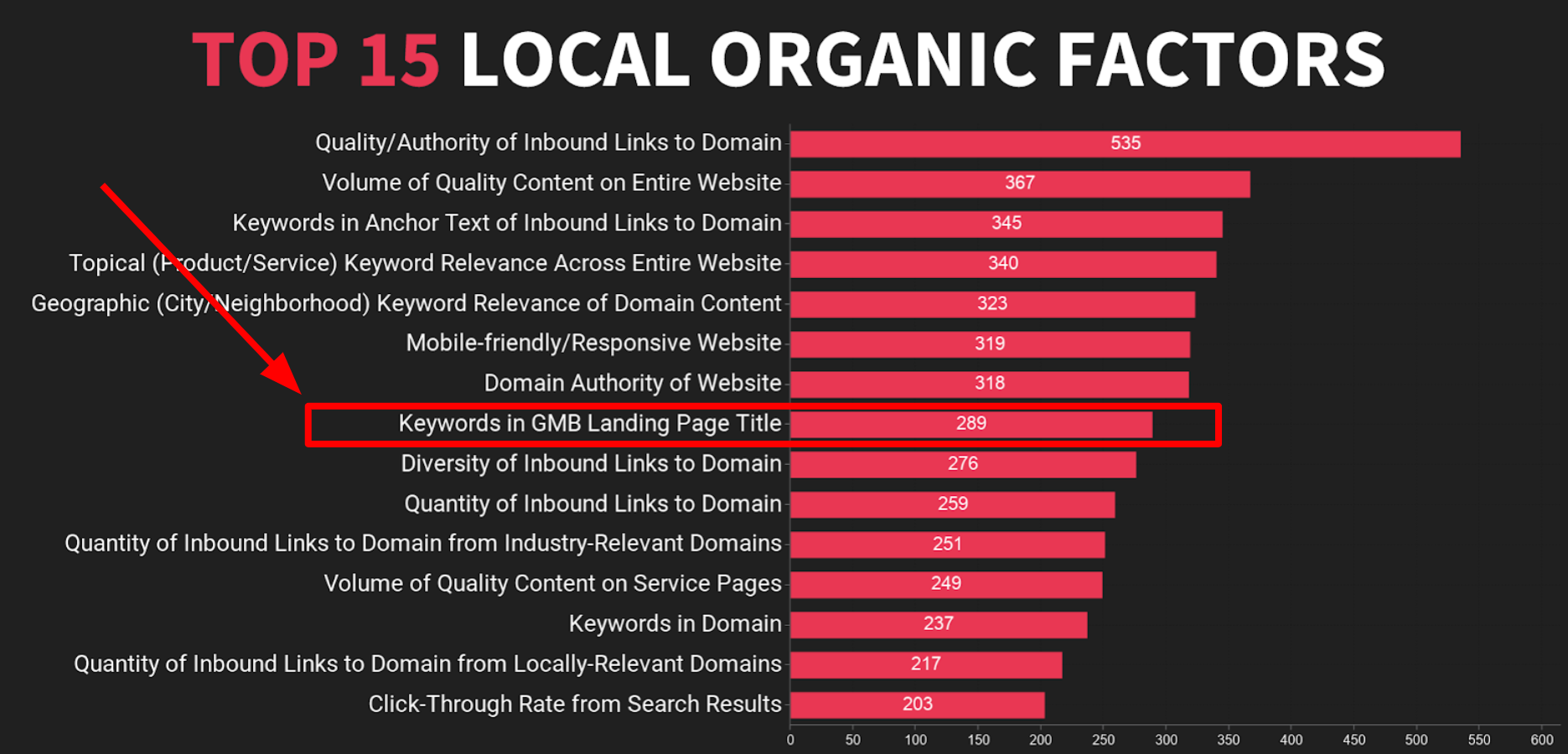 It’s one of the most important elements, yet it’s surprising to see how many businesses have not taken the time to optimize this. This is something you see all the time and particularly with small business websites, where they have not optimized the title tag.
It’s one of the most important elements, yet it’s surprising to see how many businesses have not taken the time to optimize this. This is something you see all the time and particularly with small business websites, where they have not optimized the title tag.
Let me show you some examples here. If you look at a website in Chrome and mouse over the tabs you will see the actual title tag of the business.
This is a classic homepage title tag that says “Home”, that’s not going to be helpful for them if they want to rank for keywords. Putting home in your title tag is such a classic mistake and you see this all the time.
Otherwise, they might put in a keyword like just their business name. At least this one here, Lifeforce Chiropractic, they have the word chiropractic in their business name. 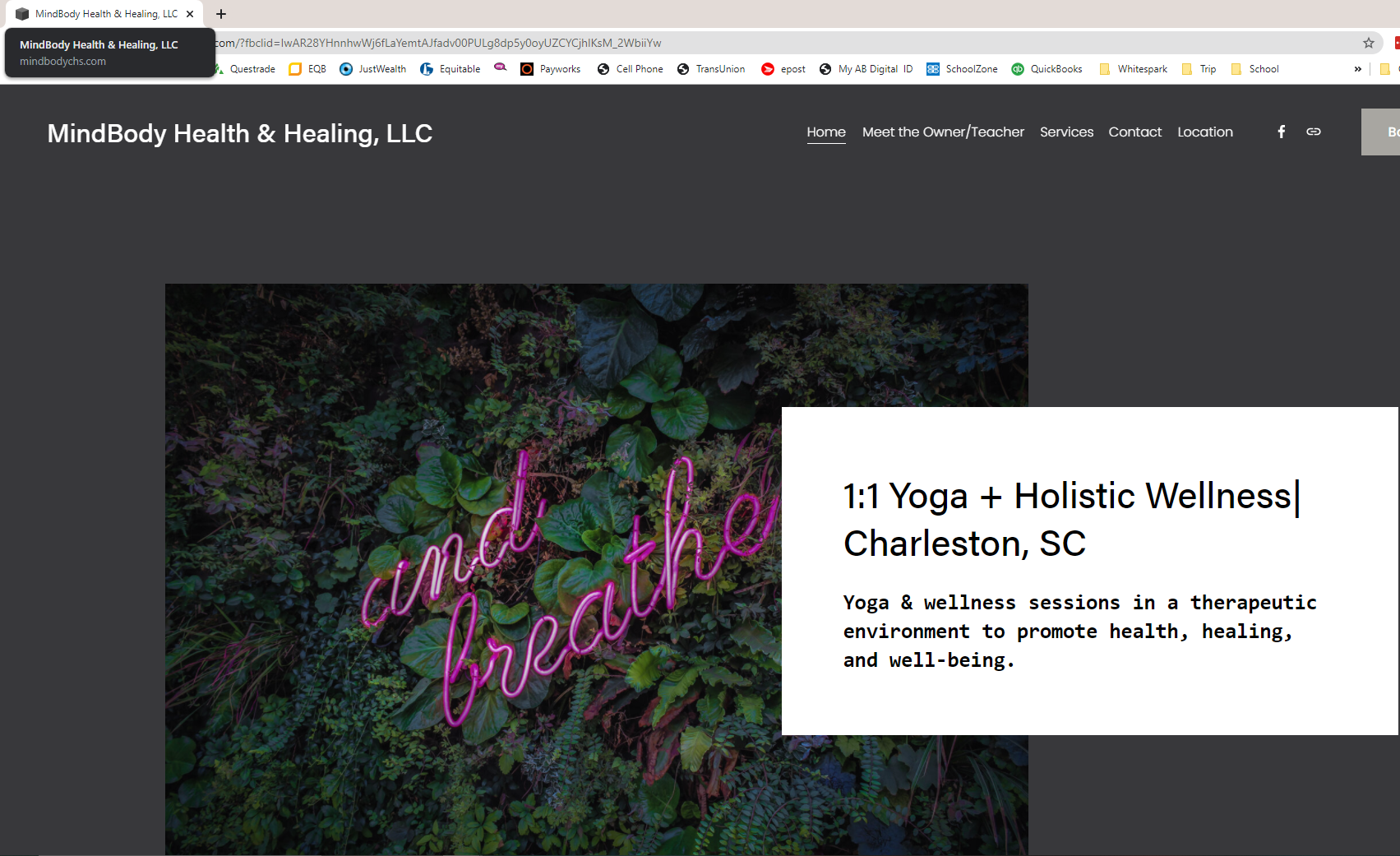
 They’re getting better. But a lot of businesses don’t have keywords of any variety in their name. In this case, you know, this title tag is Mind Body Health and Healing, this is a yoga studio, they want to rank for yoga, they need to have the key phrase yoga in the title tag.
They’re getting better. But a lot of businesses don’t have keywords of any variety in their name. In this case, you know, this title tag is Mind Body Health and Healing, this is a yoga studio, they want to rank for yoga, they need to have the key phrase yoga in the title tag.
Another one you see often is where they will combine the home with the business name. So, “Homepage Nelson Electric”, that’s not very helpful if you want to rank. You see this all the time, these different brands are putting home and then the brand name. Look at this – a major utility company in the Portland area in Oregon, their title tag is actually “Home”. 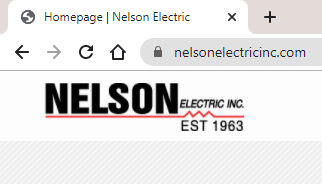
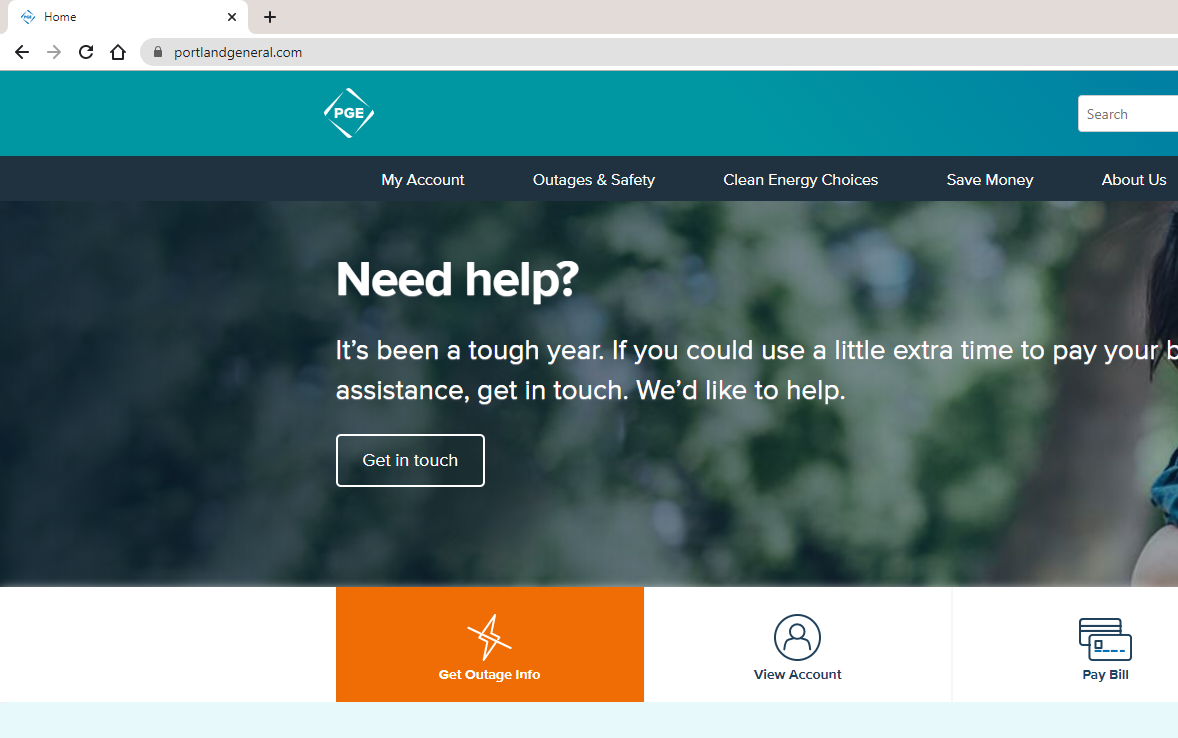 They probably spent millions of dollars on this website and their title tag says “Home”. Classic mistake. Here’s another one, Jim’s plumbing here, title tag “Home”, we’ve got to fix this.
They probably spent millions of dollars on this website and their title tag says “Home”. Classic mistake. Here’s another one, Jim’s plumbing here, title tag “Home”, we’ve got to fix this.
For the purposes of this video, I’m going to talk only about one page on your website. Obviously, there are lots of pages on your website that you’re going to need to optimize. But for this video, we’re going to focus on the page that you’ve linked to from your Google My Business listing. In the vast majority of small business cases, that is your homepage. That’s the key page that you want to make sure is optimized for local search. In some multi-location situations, it could be a specific location page. But in most cases it will be the homepage.
Step One – You want to optimize your title tag with keywords. How do you know which keywords to optimize for?
I typically recommend you start with your primary category in Google My Business. For most businesses, the primary category is something like plumber, or criminal defense attorney, or chiropractor. There’s a really great seed keyword for you to use as your starting point to identify other keywords.
Now you take that and you feed it into a keyword research tool. I like to use the Google Ads Keyword Planner. It’s free. Anyone with a Google account can use it and it’s going to give you search volume data so you can understand what terms are searched more than other terms.
Let me show you by example, exactly how I would write a title tag for this business here, Jim’s Plumbing Troubleshooters. Jim’s Plumbing Troubleshooters suffers from the classic case of homepage title tag with the title “Home”. Let’s run them through the Keyword Planner. I want to log into the Keyword Planner and I want to go to the discover new keywords, click that and start with a base keyword. 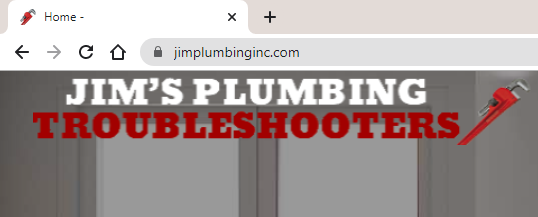 This business’s primary category is “plumber” in Google My Business, so I type in “plumber”, and I go get results. Now I can see a list here of all of these keyword ideas – very helpful. I can see that plumber, of course, is very important with 49,000 search volume monthly average monthly searches, plumbers near me comes in second with 27,000. Then Plumbing Services at 1,900, emergency plumber at 1,600.
This business’s primary category is “plumber” in Google My Business, so I type in “plumber”, and I go get results. Now I can see a list here of all of these keyword ideas – very helpful. I can see that plumber, of course, is very important with 49,000 search volume monthly average monthly searches, plumbers near me comes in second with 27,000. Then Plumbing Services at 1,900, emergency plumber at 1,600.
I can dig through this and identify a number of keywords that I would want to rank for. I can put these together in a list and I’m going to separate them into both keywords and what I consider modifiers. So the keywords I pulled out of the Keyword Planner are plumber, plumbers, plumbing, plumbing companies, and then the modifiers would be terms like near me, emergency and best.
Those are the terms that I was able to pull out of the AdWords Keyword Planner, I keep calling it AdWords actually Google Ads.
Step Two – Next, we should figure out what locations we want to target. Basically, you always want to start with the primary city you’re in and the state. So, city + state is a given. You need that in your title tag for any business that’s trying to rank locally. In this case, we’ve got plumber in Dallas, Oregon. But you can also add other locations, surrounding cities, you can add neighborhoods, this is really valuable to add those. Joel Headley did a really great presentation on this at the Whitespark Local Search Summit. He talked about how you can build relevance in local by adding additional terms to title tags. He talks about localities, which are basically neighborhoods, so different regions around your area. 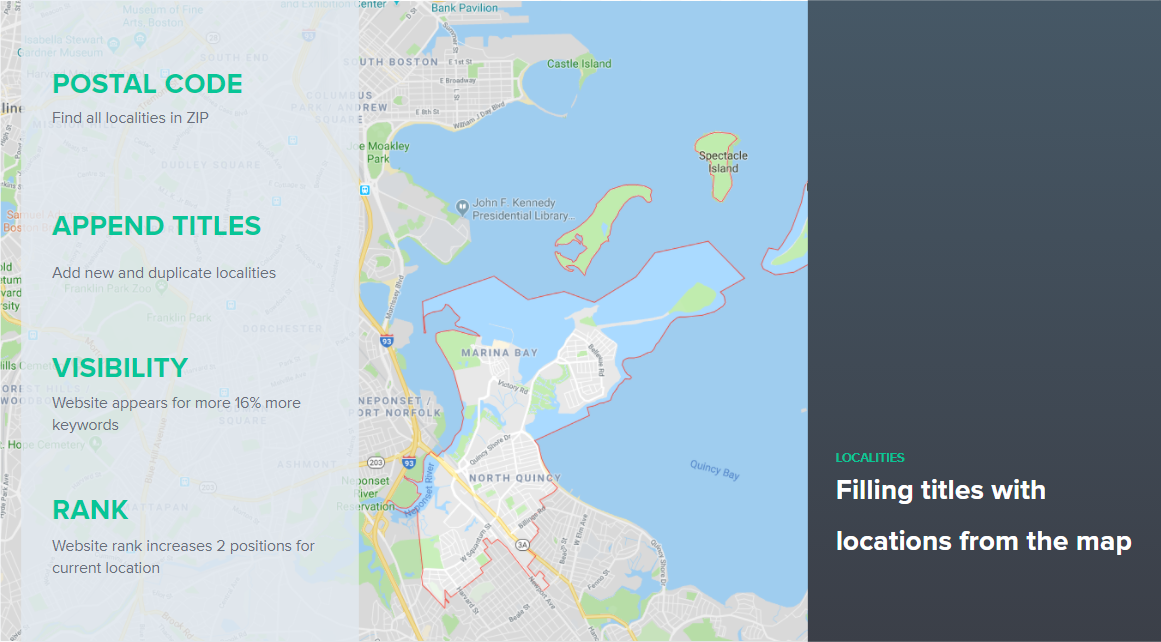 He did this great study where they had added five different surrounding localities around the primary zip code into the title tag. They did that across 1,000s of websites and they saw a 16% lift in ranking. So the website now appears for 16% more keywords. That was pretty significant. There’s a whole bunch of new terms that they’re ranking for. That’s fantastic. Their website rank increased two positions for each location. Phenomenal results just by adding all these additional neighborhoods to their categories.
He did this great study where they had added five different surrounding localities around the primary zip code into the title tag. They did that across 1,000s of websites and they saw a 16% lift in ranking. So the website now appears for 16% more keywords. That was pretty significant. There’s a whole bunch of new terms that they’re ranking for. That’s fantastic. Their website rank increased two positions for each location. Phenomenal results just by adding all these additional neighborhoods to their categories.
How do you find these different neighborhoods? What I’ll typically do is search the business address through Google Maps, and then zoom out once or zoom in. You want to find the surrounding neighborhoods.  In this case, they’re actually located in Dallas, Oregon, but the primary city that they care about is Salem, Oregon. So definitely Salem is going to be one that we want to target. Then a lot of these other ones, the bigger that they appear, and Google Maps sort of picks them out. A lot of times if you are the business owner, you know what the surrounding areas are that you want to target. But if you’re the SEO consultant, just trying to figure out you can kind of zoom in and figure it out this way.
In this case, they’re actually located in Dallas, Oregon, but the primary city that they care about is Salem, Oregon. So definitely Salem is going to be one that we want to target. Then a lot of these other ones, the bigger that they appear, and Google Maps sort of picks them out. A lot of times if you are the business owner, you know what the surrounding areas are that you want to target. But if you’re the SEO consultant, just trying to figure out you can kind of zoom in and figure it out this way.
I pulled out Chapman Corner, Hayesville, Four Corners, Morningside, Salem, and Dallas, Oregon. Those are the locations that I have selected for this particular business.
In summary, these are all the different terms that we want to target.
This is a really common question: “What about my brand name? Don’t I have to get my brand name in the title tag?” This might go against the grain, but I actually don’t recommend it for most small businesses, unless you are a recognizable brand that people directly search for. And they’re like, “Oh, yes, that’s the brand I’m looking for,” then it makes sense. But for the vast majority of small businesses, that doesn’t actually benefit you. And so I don’t actually bother putting the brand in there for a couple of reasons.
If you’re not a big brand or well known, you can skip adding your business name to the title tag and here’s why:
#1. Google will rewrite title tags in the search results if you do this thing, where you just want to tack the brand name to the end of your title tag, Google loves to move it to the front of the title tag, which is really annoying, because I may have had some primary key phrases that I was trying to target. But Google cut them off. For example, in this case, this business’s title tag is “Chicago Criminal Lawyer | DUI | Domestic Violence”, and then they put the brand name. But what Google did is they push the brand name to the front of the title tag. And so all those other important key phrases don’t get visible on the search results. So that’s, that’s one reason why you don’t want to do it.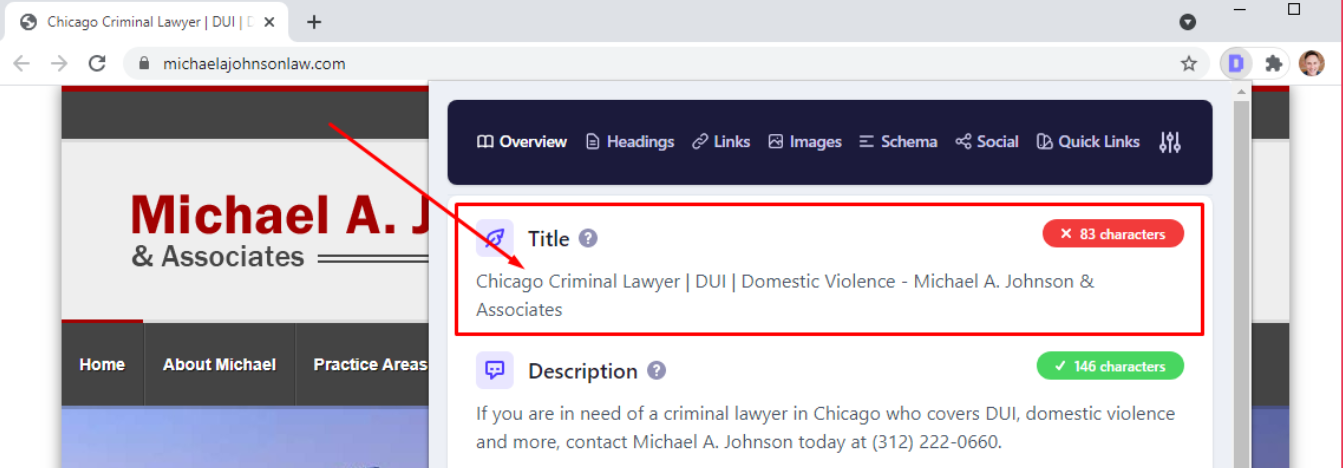
 #2. Cyrus Shepard wrote a really good post where he talked about when you might want to include the brand and the title tag, and when you wouldn’t want to include the brand’s title tag. A lot of websites have this sort of boilerplate title tag format, particularly WordPress websites, where they automatically add it to the end of every title. Sometimes, like with category pages, it can get even worse where they put the category and then the word “Shop” and all that stuff. So, this boilerplate can fill up a lot of space on your title tag.
#2. Cyrus Shepard wrote a really good post where he talked about when you might want to include the brand and the title tag, and when you wouldn’t want to include the brand’s title tag. A lot of websites have this sort of boilerplate title tag format, particularly WordPress websites, where they automatically add it to the end of every title. Sometimes, like with category pages, it can get even worse where they put the category and then the word “Shop” and all that stuff. So, this boilerplate can fill up a lot of space on your title tag.
But also, it’s kind of unnecessary. One of the things that they tested was they removed the category “Whiteboard Friday”, from all of their Whiteboard Friday videos. Amazingly, they actually saw a 20% uplift in traffic from doing that. They took that “Whiteboard Friday” out, that’s unnecessary, you don’t need to repeat that on every one of them. By doing that they saw an uplift. Those are significant results. They also tried removing the brand. That actually didn’t work out so well. Because what I said earlier, Moz is a very recognizable brand. You’re going to get more click through because people are like, “Oh, yes, Moz, I recognize that.” Having a recognizable brand, it makes sense. But without the recognizable brand, you can actually see a positive uplift by getting less words in your title tag. So, instead of putting the brand in the title tag, I actually think it makes more sense to put the brand into the description. This way, it will still show up in the search results. You’ll have more space and it doesn’t negatively impact your rankings. Look at this: Jim’s plumbing is already on the job. 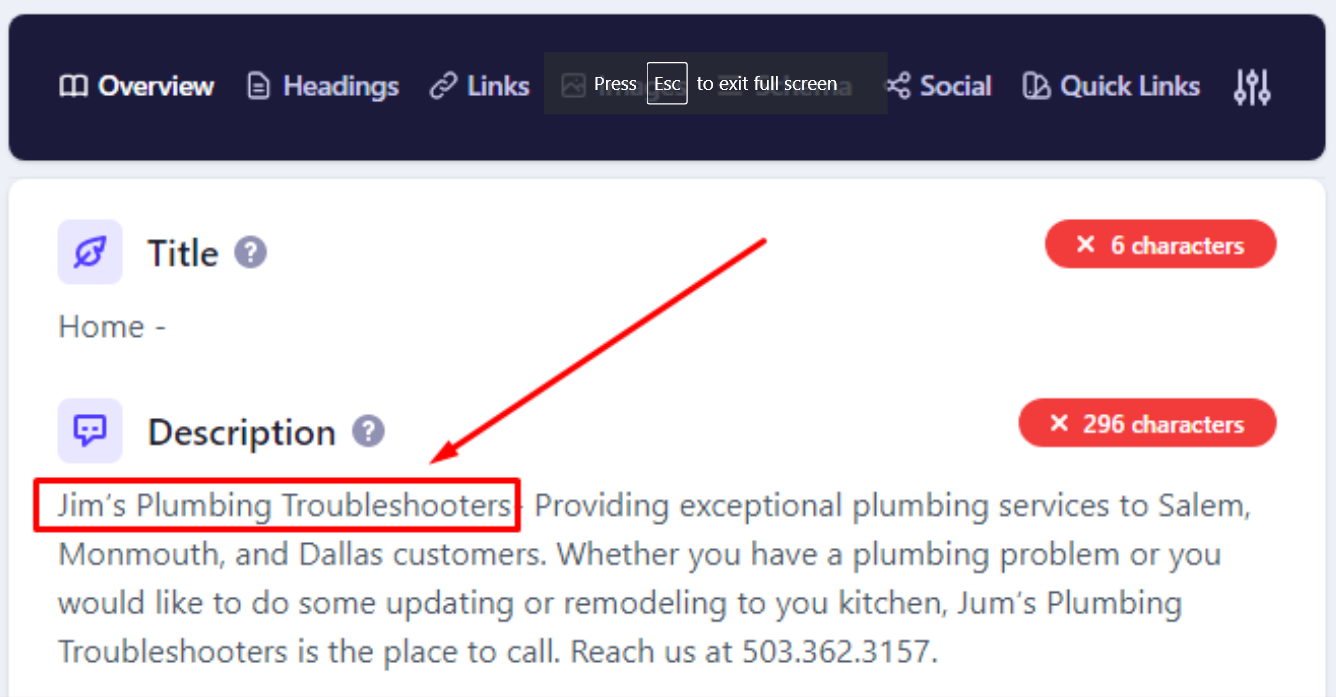 Good job, Jim. Even though the title tag says “Home”, he’s got “Jim’s Plumbing Troubleshooters” right in the description.
Good job, Jim. Even though the title tag says “Home”, he’s got “Jim’s Plumbing Troubleshooters” right in the description.
We’ve got these key phrases. We’ve decided we’re not going to do the brand. How do we get all of these terms into one title tag? Well, first of all, how long should the title tag be? If you look on Google, you will see 50 to 60 characters. Wrong. It’s definitely longer than that. You have more room to add to your title tag.
There are a ton of articles about this. They will tell you this arbitrary limit, because that’s generally what Google will display in the search results. But actually, just recently, Google has come out and said that the title tag length is an arbitrary limit that was developed by SEO companies. So there actually is no defined limit. Google’s algorithm doesn’t think about how long your title tag should be. It’s just been sort of put together based on what is actually displayed in the search results.
As Joel Headley likes to say,
“Don’t fear the ellipsis.”
There’s a lot of stuff you can put after the “dot dot dot” that will positively impact your rankings. In his case, they added the localities or neighborhoods to their title tags, and they saw an uplift in all of their rankings by adding those extra key phrases. Whatever is past what’s displayed in search results is still being considered by Google and will still positively impact your search results. Definitely don’t limit your title tag by any arbitrary length.
Now that we know that space isn’t a concern, let’s take a first crack at writing a title tag with our terms. I’m using this great little tool from Merkle (TechnicalSEO.com) they have a Google SERP Simulator, which allows me to write my title tag in a snippet preview mode so I can see how the title tag is coming together. I put in the URL I fetch is going to give me my existing title tag and pull my description. Now I’m just going to paste in all those dang words.  I pasted in all the keywords and it shows you the title tag. Obviously, we do not want our title tag to just be a keyword dump. That’s not the right approach. But this tool allows me to get a starting point of how I want my title tag to look and I can start working from there.
I pasted in all the keywords and it shows you the title tag. Obviously, we do not want our title tag to just be a keyword dump. That’s not the right approach. But this tool allows me to get a starting point of how I want my title tag to look and I can start working from there.
I just want to use this as my template to get all of these other keywords in here including the locations. I’ve come up with “Jim’s Plumbing The Best Plumbers in Dallas, Oregon, Nevada, Salem, Morningside, Hayesville, Four Corners, Chapman”.
My title tag it’s pretty long now. I’ve also added “Plumbing Companies near me”, and “Emergency Plumbing Companies near me”. There we go, that’s my title tag that is acceptable.
I basically got the key phrases that I want, and the locations I want in the title tag, these terms will help me rank. And if you look at [the preview], it says “Jim’s Plumbing The Best Plumbers in Dallas, Oregon, Salem…”
So that’s pretty good, but we can make it better. The next step is to make it catchy. The idea is to make it compelling for a person reading that to click it. If you look at the search results, you’re gonna see so many of them are just a keyword dump. Make yours stand out and you’re going to improve your click through rate and get more clicks from the search results than your competitors.
Let’s look for some good examples. We’re looking for words that are going to instill trust and really speak to the searcher. They are looking for words that are going to tell them why they should click on your listing and not one of the hundreds of other businesses. If I just kind of look through the search results, I’m going to go through a few of them.
Examples:


 Look at this one. I’ve highlighted this whole thing in red because I think it’s a really great example: The Great Plumbing Co. – Toronto Plumbers You Can Count On, when you see this in the search results against all of the other ones which are just a dump of the keywords, that speaks to me, I’m going to click on that one. I want a plumber I can count on. And they’re great. One of these great plumbers. So there we go.
Look at this one. I’ve highlighted this whole thing in red because I think it’s a really great example: The Great Plumbing Co. – Toronto Plumbers You Can Count On, when you see this in the search results against all of the other ones which are just a dump of the keywords, that speaks to me, I’m going to click on that one. I want a plumber I can count on. And they’re great. One of these great plumbers. So there we go.  Now regarding where title tag length matters. It’s really what is displayed in the search results. So that’s where we’re getting at that like 50 to 60 character limit. Because you can see that if your title tag is too long, a lot of those key phrases that you want the searcher to actually see could get cut off.
Now regarding where title tag length matters. It’s really what is displayed in the search results. So that’s where we’re getting at that like 50 to 60 character limit. Because you can see that if your title tag is too long, a lot of those key phrases that you want the searcher to actually see could get cut off. 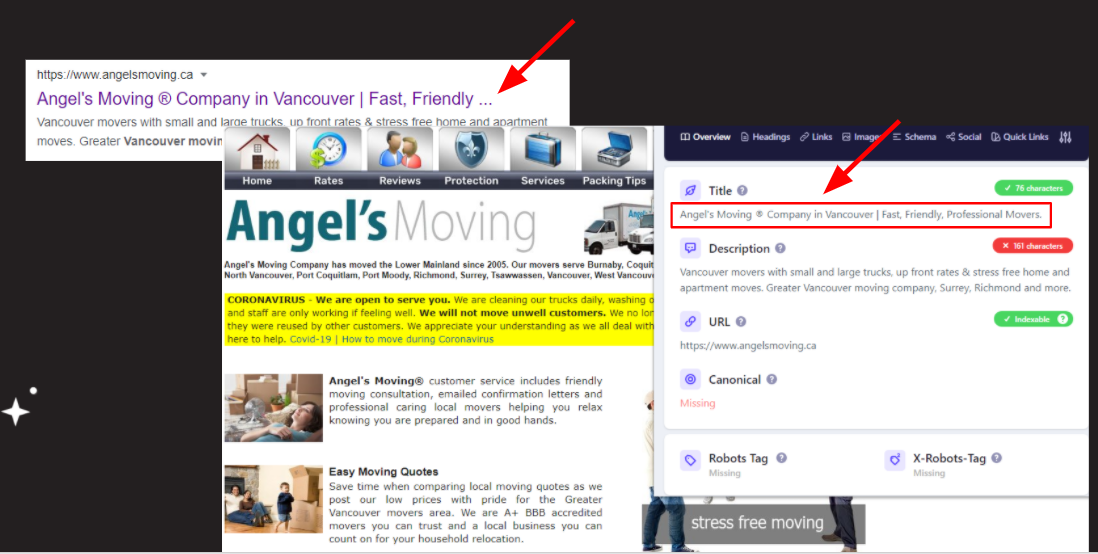 So this business here, their title tag is actually Angels Moving Company in Vancouver | Fast, Friendly, Professional Movers.
So this business here, their title tag is actually Angels Moving Company in Vancouver | Fast, Friendly, Professional Movers.
Fast, friendly, professional movers, that’s what you want to catch. You want them to see that. But it’s been cut off because Angel’s moving company in Vancouver, they’re stuffing those keywords in the beginning and it’s actually taking up space, removing those sort of compelling words. And so, this is where you’ve got to think about what is going to fit in the search results.
Okay, with this in mind, how can I make Jim’s title tag even better? We had all the keywords in it. Now let’s make it catchy. I’ve updated his title tag, to Jim’s Plumbing in Salem, OR – Plumbers You Can Trust and Count On.
So I’ve got plumbing, Salem, Oregon – that’s his primary market that he’s targeting, and “plumbers you can trust and count on”. (Now on gets cut off, but I actually kind of like it. Because it’s like, oh, well, what’s next I want to read what’s next. The ellipses is actually, I think, providing some interest to continue reading. I think people can maybe fill in the blank too.)
It’s also noteworthy that on mobile, the full title tag would actually get displayed or more of the title tag will often get displayed. If I switch to mobile, I can see – Jim’s Plumbing in Salem, OR – Plumbers You Can Trust and Count On – Service In … (I’ve got service in Dallas, Morningside, Hayesville, Four Corners, etc.) But I also know that these other terms are very important. So I want to target emergency, I want to target plumbing companies repair, and near me. So I’ve added even this to the end, Emergency Plumbing Companies and Repair Near Me. This, I believe is a wonderful title tag for Jim.
Jim’s Plumbing in Salem, OR – Plumbers You Can Trust and Count On – Service In Dallas, Morningside, Hayesville, Four Corners – Emergency Plumbing Companies and Repair Near Me
Jim, if you’re watching, you’re welcome.
Alright, to wrap it up, I’ve got a quick summary of the tips.
I hope this helps you write your title tags. In the future if you’re looking for professional software and services to improve your rankings and local search visibility, we have all kinds of software and services available at Whitespark.
If you’re enjoying these videos, please subscribe and turn on alerts. And we’d love for you also to subscribe to our newsletter. Thanks, everybody. See you next time.


Whitespark provides powerful software and expert services to help businesses and agencies drive more leads through local search.
Founded in 2005 in Edmonton, Alberta, Canada, we initially offered web design and SEO services to local businesses. While we still work closely with many clients locally, we have successfully grown over the past 20 years to support over 100,000 enterprises, agencies, and small businesses globally with our cutting-edge software and services.